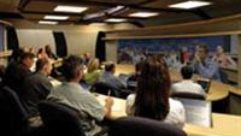
The Look and Feel of Telepresence, Part 1
Dec 13, 2007 12:00 PM,
By Jessaca Gutierrez
More On Telepresence

It seems at every twist and turn there’s another product geared toward making life—from home to the office—just a little bit easier—and clearer, and faster, and, well, you get the idea, but when it comes to videoconferencing, what about more natural and real? That’s telepresence’s aim.
Telepresence is conferencing made to be as natural and realistic as meeting in-person—despite participants being on opposite sides of the globe—through the artistic use of life-size high-resolution flatpanels, ambient lighting, décor, and most importantly a high bandwidth—very high bandwidth capable of steadily streaming video anywhere from 5Mbps to 20Mbps, depending on number of sites, screens, and pixels per screen. In many telepresence room setups, the cameras, microphones, loudspeakers, and cabling are hidden from view or camouflaged—all to give participants the physiological cues and feelings, such as eye contact and hand gestures, that come with meeting in person. The technology shouldn’t even be noticed, but your shaky, sweaty palm just might be, if for instance, you’re in the middle of negotiations or maybe someday a job interview.
Videoconferencing, on the other hand, is video communication that isn’t trying to mimic real-world likeness, so the screens are usually smaller, the video may not be as crisp, audio may lag or be of poor quality, and it usually doesn’t require as much bandwidth. In short order, the technology wasn’t designed to make you feel like you’re meeting face to face, but rather an extension of the telephone.
Although telepresence is essentially videoconferencing by any other name, just with more pizzazz and more bucks, there’s been initiative from manufacturers to stay away from that term because of the impression surrounding the term videoconferencing. When Cisco Systems debuted its TelePresence system last year, many people said, “Oh, it’s better videoconferencing,” says Erica Schroeder, director of market management at Cisco Systems. Schroeder says users finally caught on to the differences after about a year.
Because telepresence is designed to give you a true-to-life experience, the HD camera in the Cisco System is stationary. Features such as pan and zoom aren’t available like they are in most videoconferencing systems. Although this might seem to be a caveat to the system, its absence was well thought out.
“[Developers] did a lot of research about the size of the displays that are used to make people feel like they were at the same table, that’s why there aren’t features like you would find in videoconferencing where you can move the camera around, because you don’t get different points of view when you are in a real meeting—you get the view that your own eyes have,” Schroeder says.
The Look and Feel of Telepresence, Part 1
Dec 13, 2007 12:00 PM,
By Jessaca Gutierrez
More On Telepresence

What sparked Cisco to rethink the videoconferencing box? Schroeder says that because many of the developers responsible for creating Cisco’s TelePresence system came out of the video industry, they knew what struggles needed to be laid to rest with traditional videoconferencing: difficulty of use and the unnaturalness of the system. The developers came up with a set of rules, called “The Rules of Telepresence,” that the system should ultimately fulfill. “They include things like: It has to have an extremely natural interface. The technology should not be obtrusive in any way. In fact, you should forget about the technology once you start using it,” Schroeder says. “You should have an immersive experience, meaning you actually feel like you are sitting around the room with participants who may be virtual or who may be there in person, so there should be no break whether you are there in person or not. You should be able to share items just as naturally as you would in a real meeting, whether that’s a PowerPoint slide or a physical object. The first version of TelePresence introduced is built around meetings, but the meeting must feel and behave in a way that most meetings behave, so voice should come from where the voices are actually located around the table. You should all be life-size; you should feel like when the meeting starts it starts and when the meeting ends it ends, meaning essentially that you hit a button to start a meeting and hit a button to stop the meeting.”
Although the system was designed to be as natural and life-like as possible, Schroeder says that Cisco did add a function—at customer request—that isn’t necessarily naturally present in an in-person meeting: mute. “What we find is that in a real meeting is that people can have sidebar conversations. And for applications like doing negotiations or something like that, there is a legitimate need to allow people to do a sidebar conversation privately,” she says. The team also added a hold function, which allow for short breaks for long meetings and prevent participants from having to disconnect the current session and dial back in when the meeting resumes. “All those things together are what the team built, and they called it ‘telepresence’ because they didn’t want people to think that it was the same as what people normally associate the term videoconferencing with.”
The Look and Feel of Telepresence, Part 1
Dec 13, 2007 12:00 PM,
By Jessaca Gutierrez
More On Telepresence
Natural Audio
For telepresence systems, audio, second to the visual component, is the most important part of the meeting. It’s what carries the meeting. “There is zero latency in the audio, so when one half of the room tells a joke the other half should laugh—appropriately. …So it should feel very natural,” Scroeder says.
In a blog post by Josh Bernoff, vice president and principal analyst at Forrestor Research, a technology and market research company, Bernoff described the system as persuasive: “The other thing I found interesting was this: Charlene made some suggestions about pieces of the book that would require significant rewriting and rethinking. All writers know the internal resistance that this provokes, and it’s involuntary. On the phone, when this happens, I just “go along” and figure I’ll prove her wrong later, or maybe come around to her point of view. But with telepresence, I found her much more persuasive (and harder to ignore). That is, look someone in the eye and if you’re right, they can see it. Telepresence can be persuasive. This should be interesting to people who need to persuade: salespeople and managers, for example. (Politicians?)”
The Network Backbone
You can’t talk telepresence without talking about network infrastructure needs. And once again we’re seeing the common theme of convergence. As an integrator, it’ll be your job to make sure the company’s network is ready to meet the needs of a telepresence system. As mentioned earlier, for a system such as Cisco’s, the network will need to be able to support anywhere from 5Mbps to 20Mpps—depending on the number of sites, screens, and pixels per screen—to output telepresence-quality communication.
In the part 2 of The Look and Feel Telepresence, we’ll get additional insight from HP’s Halo Chief Scientist Mark Gorzynski as well as the rate of use, costs, and where this technology is heading.









